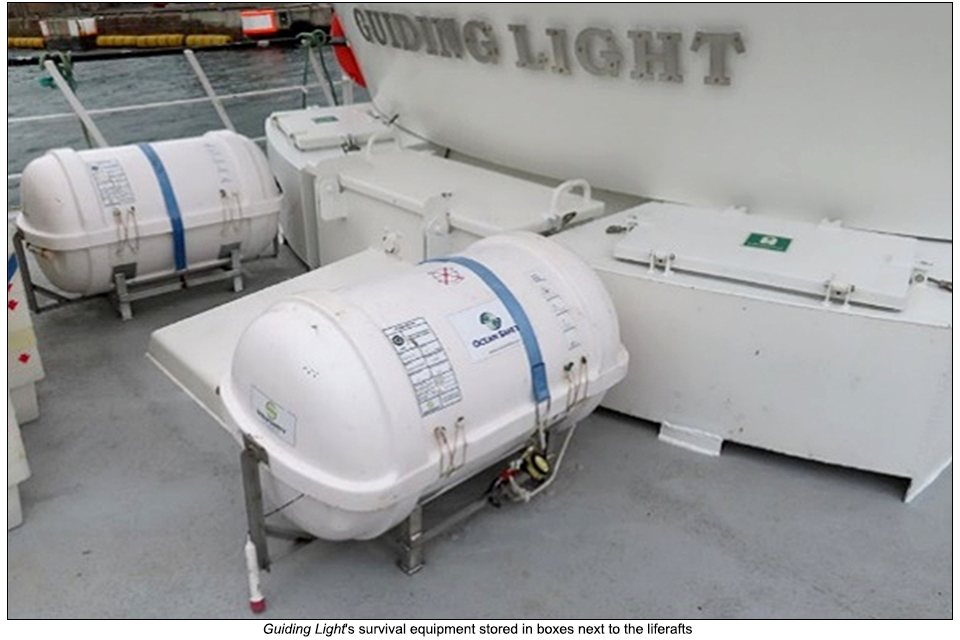Safety flyer to the fishing industry - Guiding Light and Guiding Star
Published 3 October 2024
1. Summary
Collision between the pair trawlers Guiding Light (H 90) and Guiding Star (H 360) resulting in the flooding and sinking of Guiding Star 33 nautical miles south-east of Fair Isle, Scotland on 6 October 2022

2. Narrative
At about 1149 on 6 October 2022, the pair trawlers Guiding Light and Guiding Star collided 33 nautical miles south-east of Fair Isle, Scotland, resulting in the flooding and sinking of Guiding Star. The vessels had completed their last haul of a six-day fishing trip, and the cod end of Guiding Star’s net was being transferred to Guiding Light when the vessels drifted together and collided in the rough sea conditions. Guiding Star’s stern was breached, and water flooded the aft compartment. The crew attempted to pump out the floodwater but were unsuccessful.
Guiding Star started to sink by the stern, and the crew launched the liferaft while its skipper made a distress call and, shortly afterwards, gave the order to abandon ship. The lifejackets and immersion suits were stored inside the flooded area, and the crew could not access them despite attempts to do so. Fortunately, Guiding Light’s crew transferred their own survival equipment across to Guiding Star’s crew, who donned the gear and abandoned into the liferaft.
Guiding Light’s crew used the vessel’s power block to lift two of Guiding Star’s crew on board before a large wave struck and capsized the liferaft. The six occupants were thrown into the water but were able to swim back to and grab hold of the overturned liferaft. Three of the six crew members were recovered from the water using Guiding Light’s power block and the last three crew members were winched to safety by a coastguard rescue helicopter. There were no serious injuries, and Guiding Star sank about an hour after the collision.
3. Safety lessons
-
Guiding Light’s wheelhouse was left unattended during the fish transfer. Leaving the wheelhouse unattended, even for short periods, can have catastrophic consequences. MAIB data indicates this remains prevalent in the fishing industry, and the risks of not keeping a safe watch are neither fully appreciated nor controlled. Marine Guidance Note (MGN) 313 (F) requires watchkeepers to stay in the wheelhouse to maintain a safe navigational watch. It instructs them to avoid distractions and consider the impact of fishing operations on their primary responsibilities.
-
Guiding Star did not meet any damage stability criteria. It was not constructed to withstand progressive flooding, and the bilge pumps were not designed to manage floodwater. When floodwater entered the hull, it would have caused a rapid reduction in buoyancy and loss of stability. It is therefore crucial to be prepared for such emergencies and to know when to abandon ship. This includes familiarity with the stability information book and understanding the vessel’s survivability. The Fishermen’s Safety Guideprovides guidance to help crews develop flood action plans, and MGN 570 (F) offers drill scenarios to practice such plans.
-
The commendable decision to equip both vessels with immersion suits significantly improved the chances of survival of those who entered the water, mitigating the effects of cold water shock and cold incapacitation. Without immersion suits, it is highly likely that the crew would have been unable to help themselves or would have become unconscious. Fishing vessel owners and skippers should assess the need for specific lifesaving appliances by evaluating the risks associated with their vessel’s operation, including its location and prevailing weather, which may mean going beyond simple regulatory compliance.
-
The lifejackets and immersion suits on board Guiding Star were stored in crew cabins, rendering them inaccessible before abandonment because they were located inside a flooded compartment. MGN 570 (F) advises fishermen to consider suitable storage locations for lifejackets. On board Guiding Light, the survival equipment was stored in weathertight boxes next to the liferafts, meaning it was readily accessible in an emergency.

4. Further information
Our accident investigation report is available at: https://www.gov.uk/maib-reports/collision-between-pair-trawlers-guiding-light-and-guiding-star-resulting-in-guiding-star-flooding-and-sinking
Extract from The United Kingdom Merchant Shipping (Accident Reporting and Investigation) Regulations 2012 – Regulation 5:
The sole objective of the investigation of an accident under the Merchant Shipping (Accident Reporting and Investigation) Regulations 2012 shall be the prevention of future accidents through the ascertainment of its causes and circumstances. It shall not be the purpose of an such investigation to determine liability nor, except so far as is necessary to achieve its objective, to apportion blame.
Note:
This safety flyer is not written with litigation in mind and, pursuant to Regulation 14(14) of the Merchant Shipping (Accident Reporting and Investigation) Regulations 2012, shall be inadmissible in any judicial proceedings whose purpose, or one of whose purposes is to attribute or apportion liability or blame.
Image taken from helicopter footage courtesy of HM Coastguard
Marine Accident Investigation Branch
First Floor, Spring Place
105 Commercial Road
Southampton
SO15 1GH
Email iso@maib.gov.uk
Enquiries during office hours +44 (0)23 8039 5500

